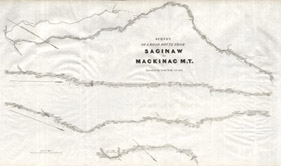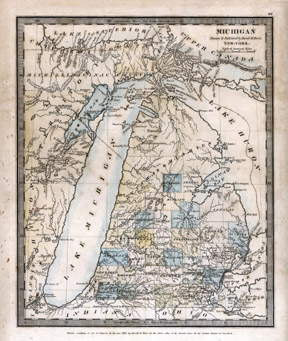
Detail from:
Bradley,
Abraham, Jr. Map of the United States, exhibiting the post-roads,
the situations,
connexions & distances of the post-offices, stage roads, counties,
& principal rivers, 3rd ed. Washington: A. Bradley Junr, 1809.
Reproduced from David Rumsey Map Collection, see http://davidrumsey.com/maps3602.html
|
Improved
roads for
travel first appeared in maps of Michigan while it was a territory.
One of the first maps depicting Michigan’s
roads was this 1809 edition of Abraham Bradley’s “Map of the United
States Exhibiting the Post Roads. This map, prepared for the Post
Office, portrays the post road from Detroit via “Frenchtown”(Monroe) to
Fort Defiance in Ohio. |

Farmer, John. Plan of the United States road from Detroit to
Chicago, as surveyed & marked by James McCloskey, Jonah Baldwin,
Laureat Durocher; copied by John Farmer.
Washington: W.J. Stone, 1825. |
In 1825, Federal
funds were appropriated for a road linking the forts at Detroit and
Chicago, and the route, following the winding and irregular path of the
ancient Sauk (Indian) trail, was surveyed later that year. This strip
(point-to-point) map of the surveyed route, known as the Chicago Road,
was copied by Farmer in 1825 and is the first Michigan map to
focus on one road. |
 
Poole,
Benjamin. Survey of a road
route from Saginaw to
Mackinac M.T. 25 Congress 2 Session, Doc. no.
234.
Executed by Lieut. Poole 3d. Art. Washington: s.n., 1837.
|
During this period,
a military road was proposed to establish a link between Saginaw with
Fort Mackinaw. In 1835, Lt. Poole was commissioned to survey this
route, one that followed the Indian path known as the Mackinaw trail.
The portrayed survey map, which accompanied his report, was also drawn
in strip format. No road passable for vehicles was constructed on this
or any other north-south route to northern Lower Michigan, however,
until several decades later.
|

Michigan. Drawn and
published by David H. Burr. New York: D. Burr, 1831.
|
Maps
portraying the entire Michigan territory, such as this 1831 Burr map,
eventually began to incorporate and reflect the major roads. The most
prominent of the roads depicted was the Chicago road, which was “at
this period one of the great thoroughfares of the country.” (Quaife,
1923, p.42) One observer counted 250 wagons in a single day and by 1835
daily stages were running from Detroit to Chicago.
A network of roads extended across the southern two tiers of counties
in Lower Michigan and expanded with settlement growth. “The system of
early roads underscored the east – west dynamic of pioneer activity”
(Dantzer, 2005 p.) .and gave Michigan maps more of an east-west
orientation rather than the north south perspective. |





